Strategic Financial Management of Next PLC: A Comprehensive Report
VerifiedAdded on 2020/01/07
|15
|5091
|82
Report
AI Summary
This report provides a comprehensive analysis of strategic financial management at Next PLC, a multinational retail brand. It examines the impact of resources, including human, financial, and physical resources, on decision-making processes. The report discusses the application of financial ratios to assess the company's performance, including asset turnover, debt-equity, and debt ratios. It evaluates strategies for managing both tangible and intangible resources, emphasizing the importance of skilled workforce and financial resources. The report also highlights the role of cost in pricing strategies and the significance of financial statements in determining the organization's financial position. The analysis includes recommendations for Next PLC to improve its financial strategies, such as focusing on attractive advertisements and maintaining a strong financial structure. The report concludes with a detailed overview of Next PLC's financial performance, highlighting its revenue, profit margins, and key financial ratios, offering insights into the company's financial health and strategic direction.
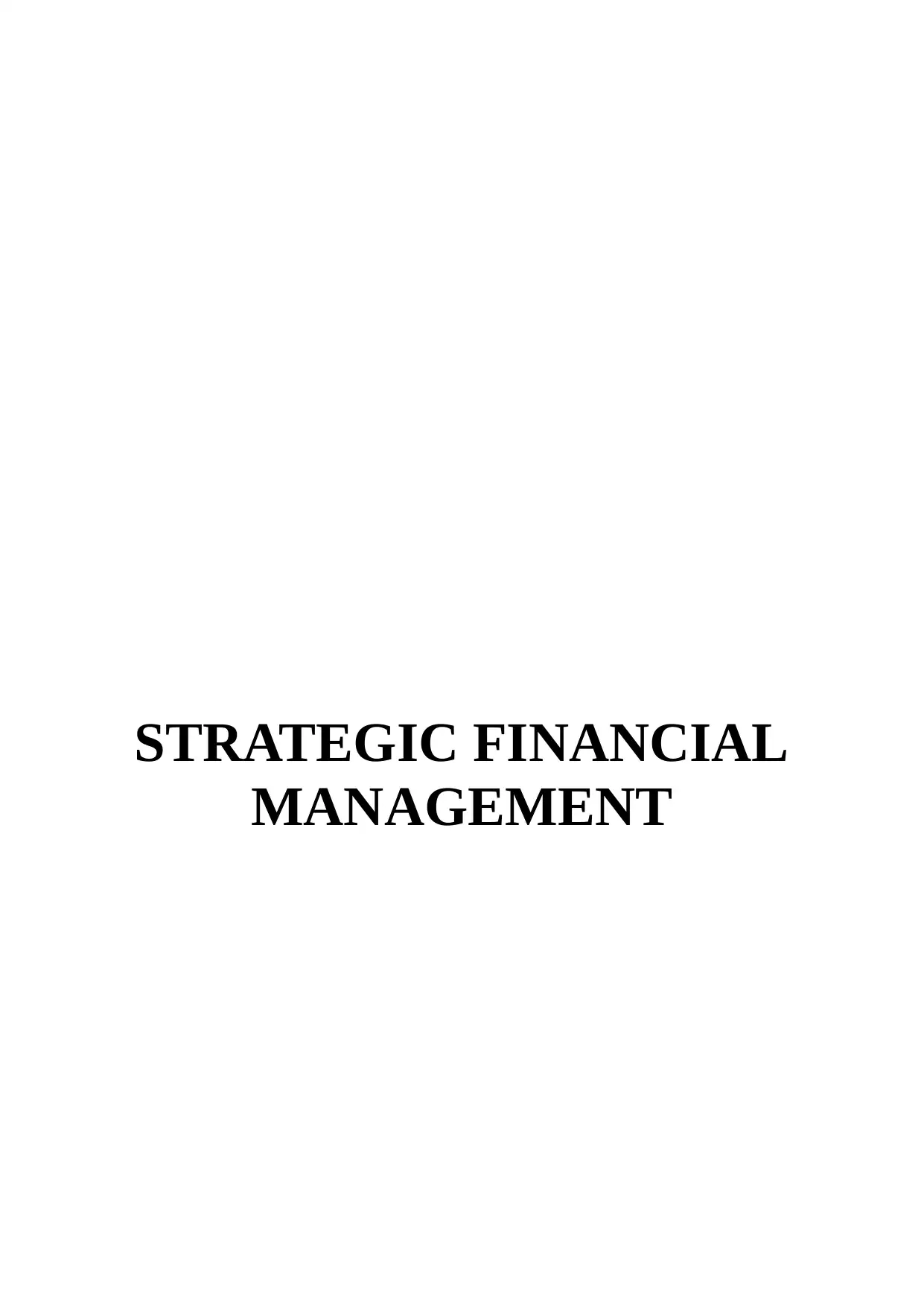
STRATEGIC FINANCIAL
MANAGEMENT
MANAGEMENT
Paraphrase This Document
Need a fresh take? Get an instant paraphrase of this document with our AI Paraphraser

TABLE OF CONTENTS
INTRODUCTION................................................................................................................................3
TASK 1.................................................................................................................................................3
1.......................................................................................................................................................3
2.......................................................................................................................................................5
3.......................................................................................................................................................6
4.......................................................................................................................................................8
CONCLUSION..................................................................................................................................10
REFERENCES...................................................................................................................................10
INTRODUCTION................................................................................................................................3
TASK 1.................................................................................................................................................3
1.......................................................................................................................................................3
2.......................................................................................................................................................5
3.......................................................................................................................................................6
4.......................................................................................................................................................8
CONCLUSION..................................................................................................................................10
REFERENCES...................................................................................................................................10

⊘ This is a preview!⊘
Do you want full access?
Subscribe today to unlock all pages.

Trusted by 1+ million students worldwide
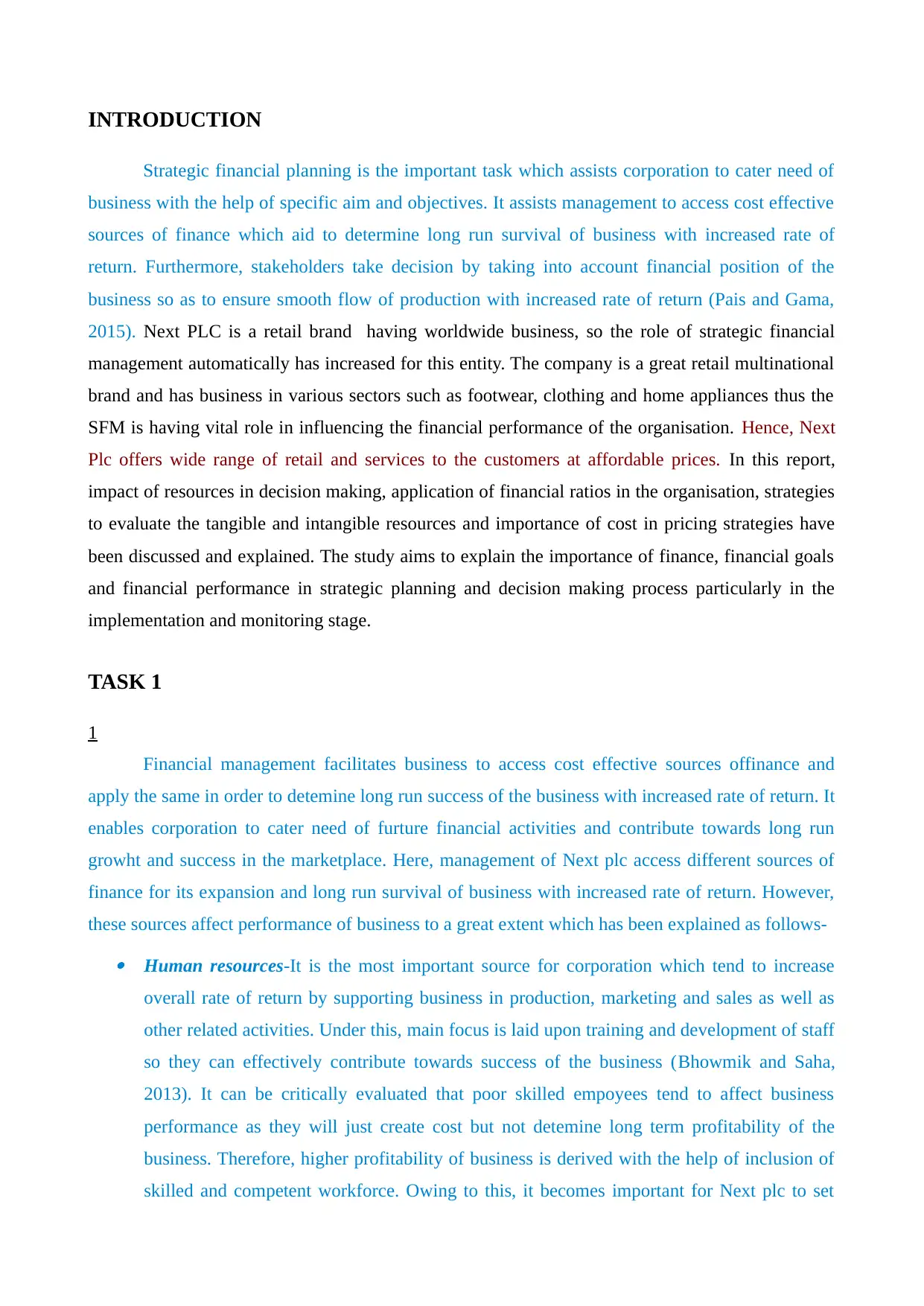
INTRODUCTION
Strategic financial planning is the important task which assists corporation to cater need of
business with the help of specific aim and objectives. It assists management to access cost effective
sources of finance which aid to determine long run survival of business with increased rate of
return. Furthermore, stakeholders take decision by taking into account financial position of the
business so as to ensure smooth flow of production with increased rate of return (Pais and Gama,
2015). Next PLC is a retail brand having worldwide business, so the role of strategic financial
management automatically has increased for this entity. The company is a great retail multinational
brand and has business in various sectors such as footwear, clothing and home appliances thus the
SFM is having vital role in influencing the financial performance of the organisation. Hence, Next
Plc offers wide range of retail and services to the customers at affordable prices. In this report,
impact of resources in decision making, application of financial ratios in the organisation, strategies
to evaluate the tangible and intangible resources and importance of cost in pricing strategies have
been discussed and explained. The study aims to explain the importance of finance, financial goals
and financial performance in strategic planning and decision making process particularly in the
implementation and monitoring stage.
TASK 1
1
Financial management facilitates business to access cost effective sources offinance and
apply the same in order to detemine long run success of the business with increased rate of return. It
enables corporation to cater need of furture financial activities and contribute towards long run
growht and success in the marketplace. Here, management of Next plc access different sources of
finance for its expansion and long run survival of business with increased rate of return. However,
these sources affect performance of business to a great extent which has been explained as follows-
Human resources-It is the most important source for corporation which tend to increase
overall rate of return by supporting business in production, marketing and sales as well as
other related activities. Under this, main focus is laid upon training and development of staff
so they can effectively contribute towards success of the business (Bhowmik and Saha,
2013). It can be critically evaluated that poor skilled empoyees tend to affect business
performance as they will just create cost but not detemine long term profitability of the
business. Therefore, higher profitability of business is derived with the help of inclusion of
skilled and competent workforce. Owing to this, it becomes important for Next plc to set
Strategic financial planning is the important task which assists corporation to cater need of
business with the help of specific aim and objectives. It assists management to access cost effective
sources of finance which aid to determine long run survival of business with increased rate of
return. Furthermore, stakeholders take decision by taking into account financial position of the
business so as to ensure smooth flow of production with increased rate of return (Pais and Gama,
2015). Next PLC is a retail brand having worldwide business, so the role of strategic financial
management automatically has increased for this entity. The company is a great retail multinational
brand and has business in various sectors such as footwear, clothing and home appliances thus the
SFM is having vital role in influencing the financial performance of the organisation. Hence, Next
Plc offers wide range of retail and services to the customers at affordable prices. In this report,
impact of resources in decision making, application of financial ratios in the organisation, strategies
to evaluate the tangible and intangible resources and importance of cost in pricing strategies have
been discussed and explained. The study aims to explain the importance of finance, financial goals
and financial performance in strategic planning and decision making process particularly in the
implementation and monitoring stage.
TASK 1
1
Financial management facilitates business to access cost effective sources offinance and
apply the same in order to detemine long run success of the business with increased rate of return. It
enables corporation to cater need of furture financial activities and contribute towards long run
growht and success in the marketplace. Here, management of Next plc access different sources of
finance for its expansion and long run survival of business with increased rate of return. However,
these sources affect performance of business to a great extent which has been explained as follows-
Human resources-It is the most important source for corporation which tend to increase
overall rate of return by supporting business in production, marketing and sales as well as
other related activities. Under this, main focus is laid upon training and development of staff
so they can effectively contribute towards success of the business (Bhowmik and Saha,
2013). It can be critically evaluated that poor skilled empoyees tend to affect business
performance as they will just create cost but not detemine long term profitability of the
business. Therefore, higher profitability of business is derived with the help of inclusion of
skilled and competent workforce. Owing to this, it becomes important for Next plc to set
Paraphrase This Document
Need a fresh take? Get an instant paraphrase of this document with our AI Paraphraser
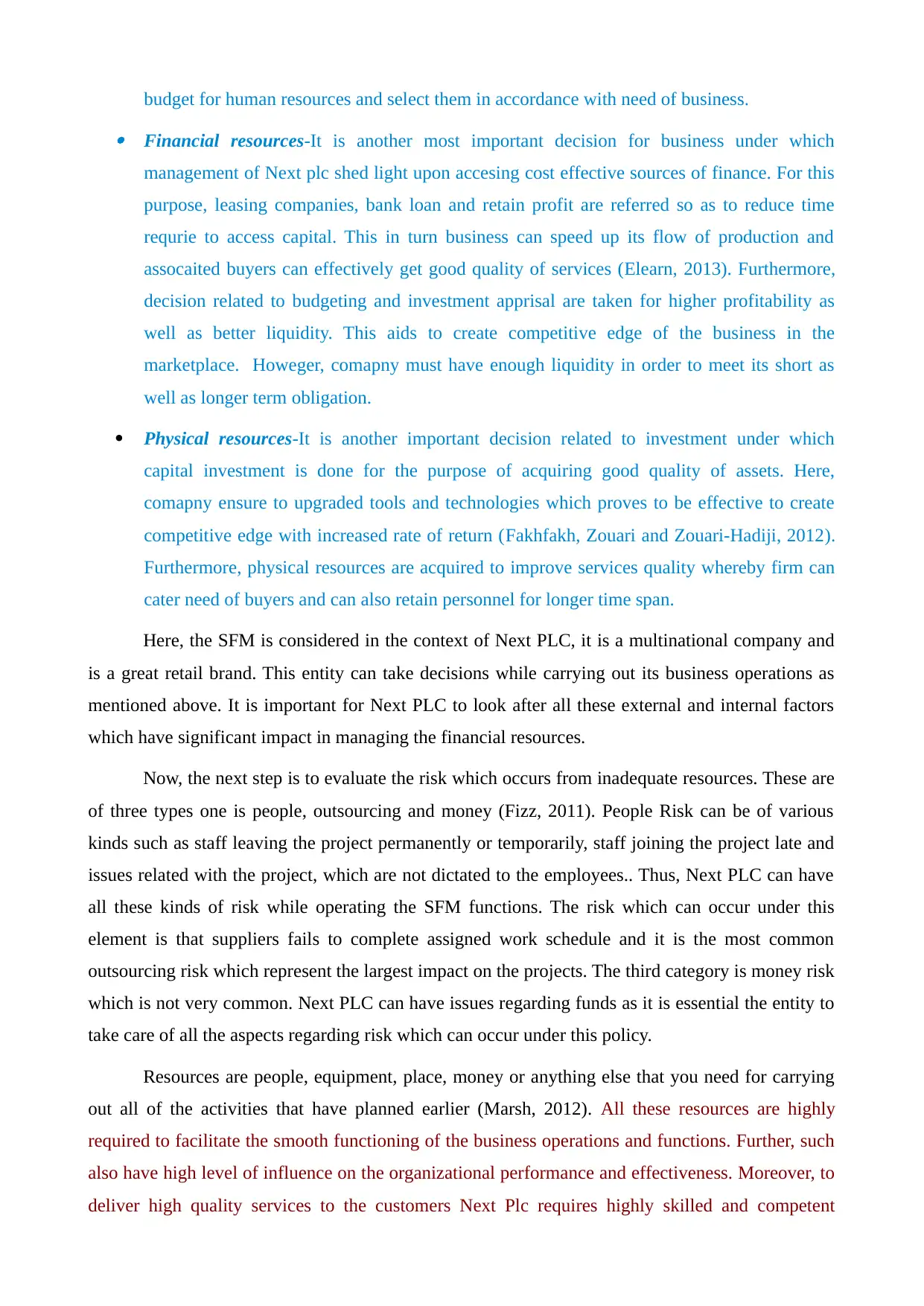
budget for human resources and select them in accordance with need of business.
Financial resources-It is another most important decision for business under which
management of Next plc shed light upon accesing cost effective sources of finance. For this
purpose, leasing companies, bank loan and retain profit are referred so as to reduce time
requrie to access capital. This in turn business can speed up its flow of production and
assocaited buyers can effectively get good quality of services (Elearn, 2013). Furthermore,
decision related to budgeting and investment apprisal are taken for higher profitability as
well as better liquidity. This aids to create competitive edge of the business in the
marketplace. Howeger, comapny must have enough liquidity in order to meet its short as
well as longer term obligation.
Physical resources-It is another important decision related to investment under which
capital investment is done for the purpose of acquiring good quality of assets. Here,
comapny ensure to upgraded tools and technologies which proves to be effective to create
competitive edge with increased rate of return (Fakhfakh, Zouari and Zouari-Hadiji, 2012).
Furthermore, physical resources are acquired to improve services quality whereby firm can
cater need of buyers and can also retain personnel for longer time span.
Here, the SFM is considered in the context of Next PLC, it is a multinational company and
is a great retail brand. This entity can take decisions while carrying out its business operations as
mentioned above. It is important for Next PLC to look after all these external and internal factors
which have significant impact in managing the financial resources.
Now, the next step is to evaluate the risk which occurs from inadequate resources. These are
of three types one is people, outsourcing and money (Fizz, 2011). People Risk can be of various
kinds such as staff leaving the project permanently or temporarily, staff joining the project late and
issues related with the project, which are not dictated to the employees.. Thus, Next PLC can have
all these kinds of risk while operating the SFM functions. The risk which can occur under this
element is that suppliers fails to complete assigned work schedule and it is the most common
outsourcing risk which represent the largest impact on the projects. The third category is money risk
which is not very common. Next PLC can have issues regarding funds as it is essential the entity to
take care of all the aspects regarding risk which can occur under this policy.
Resources are people, equipment, place, money or anything else that you need for carrying
out all of the activities that have planned earlier (Marsh, 2012). All these resources are highly
required to facilitate the smooth functioning of the business operations and functions. Further, such
also have high level of influence on the organizational performance and effectiveness. Moreover, to
deliver high quality services to the customers Next Plc requires highly skilled and competent
Financial resources-It is another most important decision for business under which
management of Next plc shed light upon accesing cost effective sources of finance. For this
purpose, leasing companies, bank loan and retain profit are referred so as to reduce time
requrie to access capital. This in turn business can speed up its flow of production and
assocaited buyers can effectively get good quality of services (Elearn, 2013). Furthermore,
decision related to budgeting and investment apprisal are taken for higher profitability as
well as better liquidity. This aids to create competitive edge of the business in the
marketplace. Howeger, comapny must have enough liquidity in order to meet its short as
well as longer term obligation.
Physical resources-It is another important decision related to investment under which
capital investment is done for the purpose of acquiring good quality of assets. Here,
comapny ensure to upgraded tools and technologies which proves to be effective to create
competitive edge with increased rate of return (Fakhfakh, Zouari and Zouari-Hadiji, 2012).
Furthermore, physical resources are acquired to improve services quality whereby firm can
cater need of buyers and can also retain personnel for longer time span.
Here, the SFM is considered in the context of Next PLC, it is a multinational company and
is a great retail brand. This entity can take decisions while carrying out its business operations as
mentioned above. It is important for Next PLC to look after all these external and internal factors
which have significant impact in managing the financial resources.
Now, the next step is to evaluate the risk which occurs from inadequate resources. These are
of three types one is people, outsourcing and money (Fizz, 2011). People Risk can be of various
kinds such as staff leaving the project permanently or temporarily, staff joining the project late and
issues related with the project, which are not dictated to the employees.. Thus, Next PLC can have
all these kinds of risk while operating the SFM functions. The risk which can occur under this
element is that suppliers fails to complete assigned work schedule and it is the most common
outsourcing risk which represent the largest impact on the projects. The third category is money risk
which is not very common. Next PLC can have issues regarding funds as it is essential the entity to
take care of all the aspects regarding risk which can occur under this policy.
Resources are people, equipment, place, money or anything else that you need for carrying
out all of the activities that have planned earlier (Marsh, 2012). All these resources are highly
required to facilitate the smooth functioning of the business operations and functions. Further, such
also have high level of influence on the organizational performance and effectiveness. Moreover, to
deliver high quality services to the customers Next Plc requires highly skilled and competent
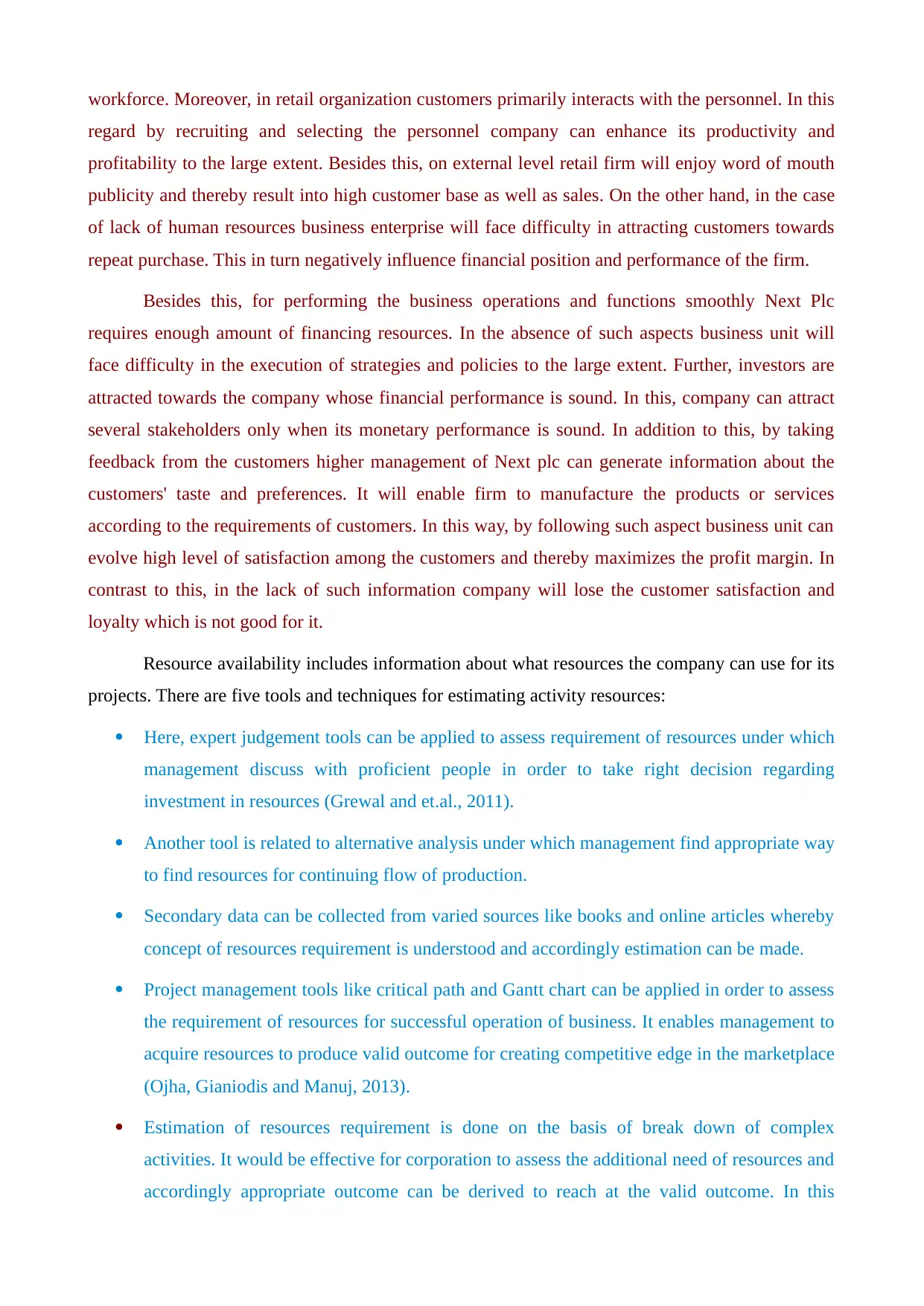
workforce. Moreover, in retail organization customers primarily interacts with the personnel. In this
regard by recruiting and selecting the personnel company can enhance its productivity and
profitability to the large extent. Besides this, on external level retail firm will enjoy word of mouth
publicity and thereby result into high customer base as well as sales. On the other hand, in the case
of lack of human resources business enterprise will face difficulty in attracting customers towards
repeat purchase. This in turn negatively influence financial position and performance of the firm.
Besides this, for performing the business operations and functions smoothly Next Plc
requires enough amount of financing resources. In the absence of such aspects business unit will
face difficulty in the execution of strategies and policies to the large extent. Further, investors are
attracted towards the company whose financial performance is sound. In this, company can attract
several stakeholders only when its monetary performance is sound. In addition to this, by taking
feedback from the customers higher management of Next plc can generate information about the
customers' taste and preferences. It will enable firm to manufacture the products or services
according to the requirements of customers. In this way, by following such aspect business unit can
evolve high level of satisfaction among the customers and thereby maximizes the profit margin. In
contrast to this, in the lack of such information company will lose the customer satisfaction and
loyalty which is not good for it.
Resource availability includes information about what resources the company can use for its
projects. There are five tools and techniques for estimating activity resources:
Here, expert judgement tools can be applied to assess requirement of resources under which
management discuss with proficient people in order to take right decision regarding
investment in resources (Grewal and et.al., 2011).
Another tool is related to alternative analysis under which management find appropriate way
to find resources for continuing flow of production.
Secondary data can be collected from varied sources like books and online articles whereby
concept of resources requirement is understood and accordingly estimation can be made.
Project management tools like critical path and Gantt chart can be applied in order to assess
the requirement of resources for successful operation of business. It enables management to
acquire resources to produce valid outcome for creating competitive edge in the marketplace
(Ojha, Gianiodis and Manuj, 2013).
Estimation of resources requirement is done on the basis of break down of complex
activities. It would be effective for corporation to assess the additional need of resources and
accordingly appropriate outcome can be derived to reach at the valid outcome. In this
regard by recruiting and selecting the personnel company can enhance its productivity and
profitability to the large extent. Besides this, on external level retail firm will enjoy word of mouth
publicity and thereby result into high customer base as well as sales. On the other hand, in the case
of lack of human resources business enterprise will face difficulty in attracting customers towards
repeat purchase. This in turn negatively influence financial position and performance of the firm.
Besides this, for performing the business operations and functions smoothly Next Plc
requires enough amount of financing resources. In the absence of such aspects business unit will
face difficulty in the execution of strategies and policies to the large extent. Further, investors are
attracted towards the company whose financial performance is sound. In this, company can attract
several stakeholders only when its monetary performance is sound. In addition to this, by taking
feedback from the customers higher management of Next plc can generate information about the
customers' taste and preferences. It will enable firm to manufacture the products or services
according to the requirements of customers. In this way, by following such aspect business unit can
evolve high level of satisfaction among the customers and thereby maximizes the profit margin. In
contrast to this, in the lack of such information company will lose the customer satisfaction and
loyalty which is not good for it.
Resource availability includes information about what resources the company can use for its
projects. There are five tools and techniques for estimating activity resources:
Here, expert judgement tools can be applied to assess requirement of resources under which
management discuss with proficient people in order to take right decision regarding
investment in resources (Grewal and et.al., 2011).
Another tool is related to alternative analysis under which management find appropriate way
to find resources for continuing flow of production.
Secondary data can be collected from varied sources like books and online articles whereby
concept of resources requirement is understood and accordingly estimation can be made.
Project management tools like critical path and Gantt chart can be applied in order to assess
the requirement of resources for successful operation of business. It enables management to
acquire resources to produce valid outcome for creating competitive edge in the marketplace
(Ojha, Gianiodis and Manuj, 2013).
Estimation of resources requirement is done on the basis of break down of complex
activities. It would be effective for corporation to assess the additional need of resources and
accordingly appropriate outcome can be derived to reach at the valid outcome. In this
⊘ This is a preview!⊘
Do you want full access?
Subscribe today to unlock all pages.

Trusted by 1+ million students worldwide
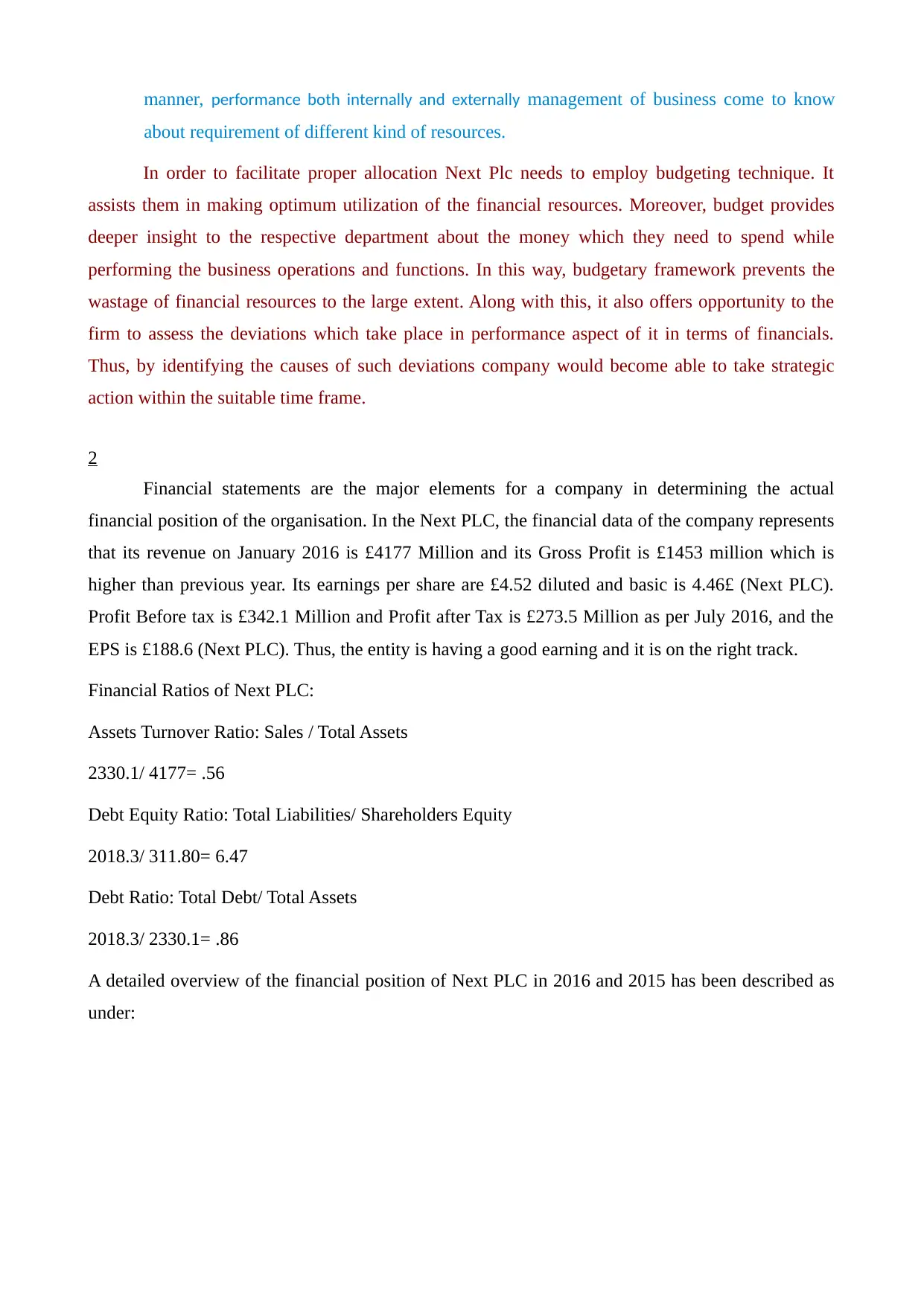
manner, performance both internally and externally management of business come to know
about requirement of different kind of resources.
In order to facilitate proper allocation Next Plc needs to employ budgeting technique. It
assists them in making optimum utilization of the financial resources. Moreover, budget provides
deeper insight to the respective department about the money which they need to spend while
performing the business operations and functions. In this way, budgetary framework prevents the
wastage of financial resources to the large extent. Along with this, it also offers opportunity to the
firm to assess the deviations which take place in performance aspect of it in terms of financials.
Thus, by identifying the causes of such deviations company would become able to take strategic
action within the suitable time frame.
2
Financial statements are the major elements for a company in determining the actual
financial position of the organisation. In the Next PLC, the financial data of the company represents
that its revenue on January 2016 is £4177 Million and its Gross Profit is £1453 million which is
higher than previous year. Its earnings per share are £4.52 diluted and basic is 4.46£ (Next PLC).
Profit Before tax is £342.1 Million and Profit after Tax is £273.5 Million as per July 2016, and the
EPS is £188.6 (Next PLC). Thus, the entity is having a good earning and it is on the right track.
Financial Ratios of Next PLC:
Assets Turnover Ratio: Sales / Total Assets
2330.1/ 4177= .56
Debt Equity Ratio: Total Liabilities/ Shareholders Equity
2018.3/ 311.80= 6.47
Debt Ratio: Total Debt/ Total Assets
2018.3/ 2330.1= .86
A detailed overview of the financial position of Next PLC in 2016 and 2015 has been described as
under:
about requirement of different kind of resources.
In order to facilitate proper allocation Next Plc needs to employ budgeting technique. It
assists them in making optimum utilization of the financial resources. Moreover, budget provides
deeper insight to the respective department about the money which they need to spend while
performing the business operations and functions. In this way, budgetary framework prevents the
wastage of financial resources to the large extent. Along with this, it also offers opportunity to the
firm to assess the deviations which take place in performance aspect of it in terms of financials.
Thus, by identifying the causes of such deviations company would become able to take strategic
action within the suitable time frame.
2
Financial statements are the major elements for a company in determining the actual
financial position of the organisation. In the Next PLC, the financial data of the company represents
that its revenue on January 2016 is £4177 Million and its Gross Profit is £1453 million which is
higher than previous year. Its earnings per share are £4.52 diluted and basic is 4.46£ (Next PLC).
Profit Before tax is £342.1 Million and Profit after Tax is £273.5 Million as per July 2016, and the
EPS is £188.6 (Next PLC). Thus, the entity is having a good earning and it is on the right track.
Financial Ratios of Next PLC:
Assets Turnover Ratio: Sales / Total Assets
2330.1/ 4177= .56
Debt Equity Ratio: Total Liabilities/ Shareholders Equity
2018.3/ 311.80= 6.47
Debt Ratio: Total Debt/ Total Assets
2018.3/ 2330.1= .86
A detailed overview of the financial position of Next PLC in 2016 and 2015 has been described as
under:
Paraphrase This Document
Need a fresh take? Get an instant paraphrase of this document with our AI Paraphraser
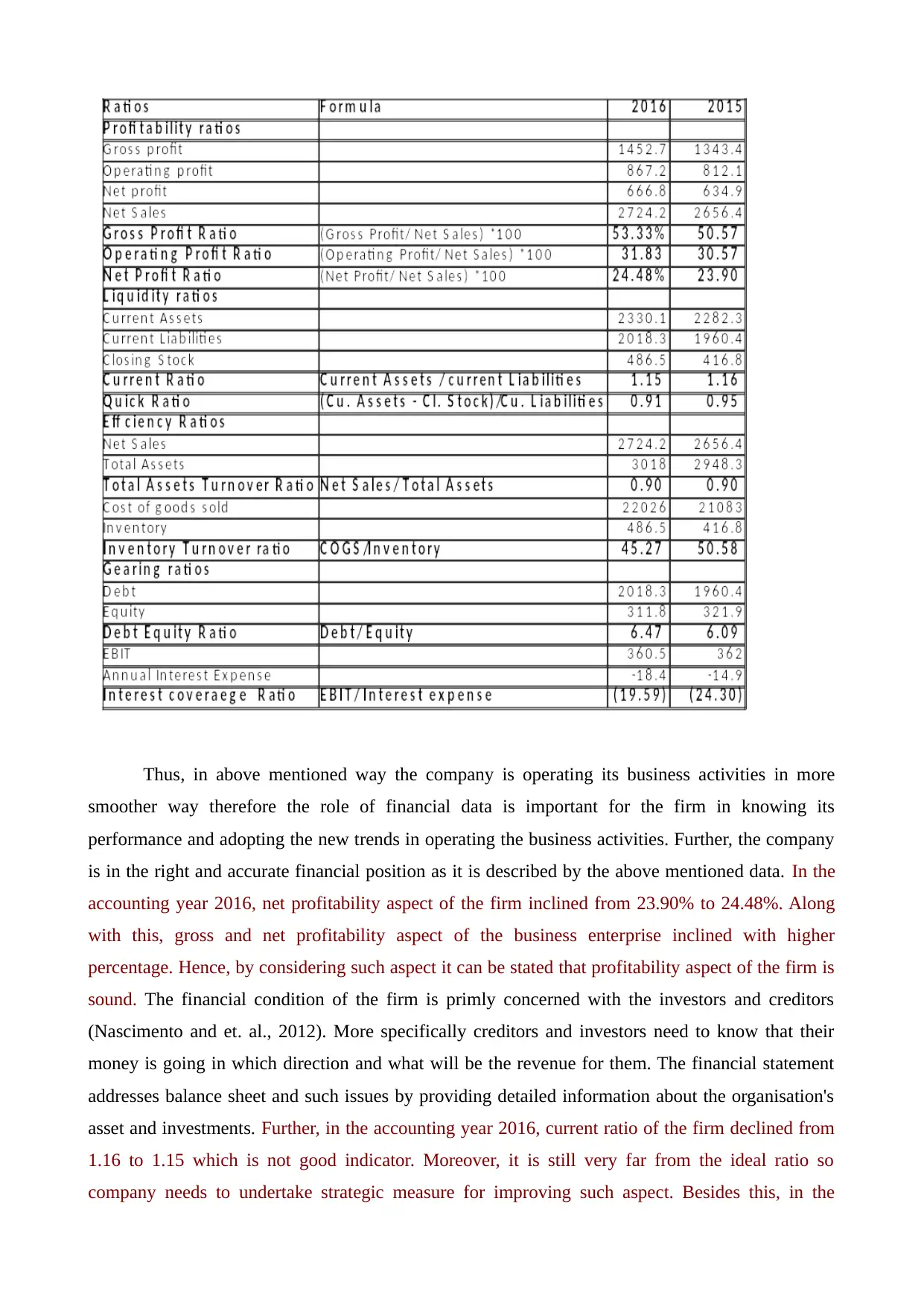
Thus, in above mentioned way the company is operating its business activities in more
smoother way therefore the role of financial data is important for the firm in knowing its
performance and adopting the new trends in operating the business activities. Further, the company
is in the right and accurate financial position as it is described by the above mentioned data. In the
accounting year 2016, net profitability aspect of the firm inclined from 23.90% to 24.48%. Along
with this, gross and net profitability aspect of the business enterprise inclined with higher
percentage. Hence, by considering such aspect it can be stated that profitability aspect of the firm is
sound. The financial condition of the firm is primly concerned with the investors and creditors
(Nascimento and et. al., 2012). More specifically creditors and investors need to know that their
money is going in which direction and what will be the revenue for them. The financial statement
addresses balance sheet and such issues by providing detailed information about the organisation's
asset and investments. Further, in the accounting year 2016, current ratio of the firm declined from
1.16 to 1.15 which is not good indicator. Moreover, it is still very far from the ideal ratio so
company needs to undertake strategic measure for improving such aspect. Besides this, in the
smoother way therefore the role of financial data is important for the firm in knowing its
performance and adopting the new trends in operating the business activities. Further, the company
is in the right and accurate financial position as it is described by the above mentioned data. In the
accounting year 2016, net profitability aspect of the firm inclined from 23.90% to 24.48%. Along
with this, gross and net profitability aspect of the business enterprise inclined with higher
percentage. Hence, by considering such aspect it can be stated that profitability aspect of the firm is
sound. The financial condition of the firm is primly concerned with the investors and creditors
(Nascimento and et. al., 2012). More specifically creditors and investors need to know that their
money is going in which direction and what will be the revenue for them. The financial statement
addresses balance sheet and such issues by providing detailed information about the organisation's
asset and investments. Further, in the accounting year 2016, current ratio of the firm declined from
1.16 to 1.15 which is not good indicator. Moreover, it is still very far from the ideal ratio so
company needs to undertake strategic measure for improving such aspect. Besides this, in the
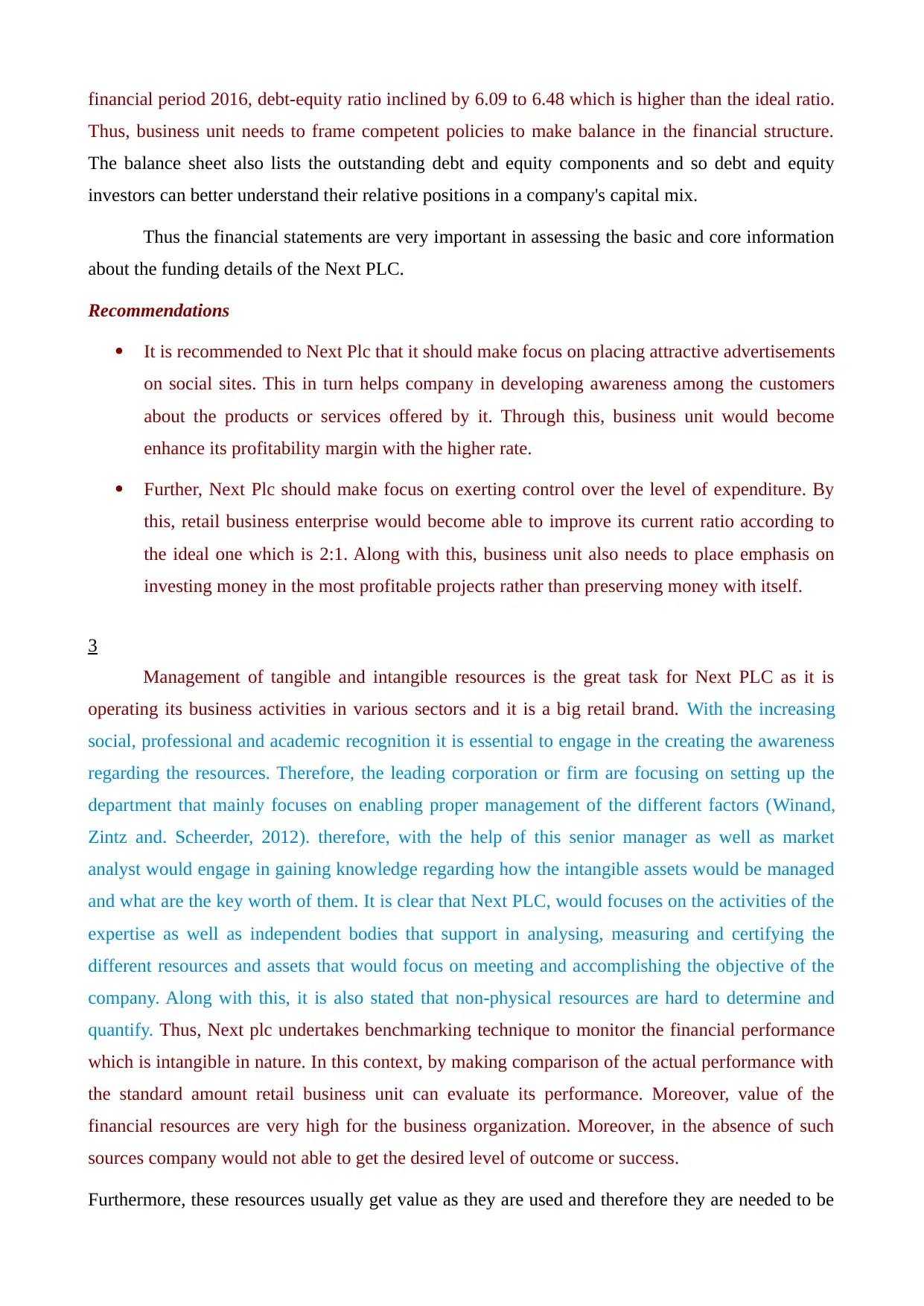
financial period 2016, debt-equity ratio inclined by 6.09 to 6.48 which is higher than the ideal ratio.
Thus, business unit needs to frame competent policies to make balance in the financial structure.
The balance sheet also lists the outstanding debt and equity components and so debt and equity
investors can better understand their relative positions in a company's capital mix.
Thus the financial statements are very important in assessing the basic and core information
about the funding details of the Next PLC.
Recommendations
It is recommended to Next Plc that it should make focus on placing attractive advertisements
on social sites. This in turn helps company in developing awareness among the customers
about the products or services offered by it. Through this, business unit would become
enhance its profitability margin with the higher rate.
Further, Next Plc should make focus on exerting control over the level of expenditure. By
this, retail business enterprise would become able to improve its current ratio according to
the ideal one which is 2:1. Along with this, business unit also needs to place emphasis on
investing money in the most profitable projects rather than preserving money with itself.
3
Management of tangible and intangible resources is the great task for Next PLC as it is
operating its business activities in various sectors and it is a big retail brand. With the increasing
social, professional and academic recognition it is essential to engage in the creating the awareness
regarding the resources. Therefore, the leading corporation or firm are focusing on setting up the
department that mainly focuses on enabling proper management of the different factors (Winand,
Zintz and. Scheerder, 2012). therefore, with the help of this senior manager as well as market
analyst would engage in gaining knowledge regarding how the intangible assets would be managed
and what are the key worth of them. It is clear that Next PLC, would focuses on the activities of the
expertise as well as independent bodies that support in analysing, measuring and certifying the
different resources and assets that would focus on meeting and accomplishing the objective of the
company. Along with this, it is also stated that non-physical resources are hard to determine and
quantify. Thus, Next plc undertakes benchmarking technique to monitor the financial performance
which is intangible in nature. In this context, by making comparison of the actual performance with
the standard amount retail business unit can evaluate its performance. Moreover, value of the
financial resources are very high for the business organization. Moreover, in the absence of such
sources company would not able to get the desired level of outcome or success.
Furthermore, these resources usually get value as they are used and therefore they are needed to be
Thus, business unit needs to frame competent policies to make balance in the financial structure.
The balance sheet also lists the outstanding debt and equity components and so debt and equity
investors can better understand their relative positions in a company's capital mix.
Thus the financial statements are very important in assessing the basic and core information
about the funding details of the Next PLC.
Recommendations
It is recommended to Next Plc that it should make focus on placing attractive advertisements
on social sites. This in turn helps company in developing awareness among the customers
about the products or services offered by it. Through this, business unit would become
enhance its profitability margin with the higher rate.
Further, Next Plc should make focus on exerting control over the level of expenditure. By
this, retail business enterprise would become able to improve its current ratio according to
the ideal one which is 2:1. Along with this, business unit also needs to place emphasis on
investing money in the most profitable projects rather than preserving money with itself.
3
Management of tangible and intangible resources is the great task for Next PLC as it is
operating its business activities in various sectors and it is a big retail brand. With the increasing
social, professional and academic recognition it is essential to engage in the creating the awareness
regarding the resources. Therefore, the leading corporation or firm are focusing on setting up the
department that mainly focuses on enabling proper management of the different factors (Winand,
Zintz and. Scheerder, 2012). therefore, with the help of this senior manager as well as market
analyst would engage in gaining knowledge regarding how the intangible assets would be managed
and what are the key worth of them. It is clear that Next PLC, would focuses on the activities of the
expertise as well as independent bodies that support in analysing, measuring and certifying the
different resources and assets that would focus on meeting and accomplishing the objective of the
company. Along with this, it is also stated that non-physical resources are hard to determine and
quantify. Thus, Next plc undertakes benchmarking technique to monitor the financial performance
which is intangible in nature. In this context, by making comparison of the actual performance with
the standard amount retail business unit can evaluate its performance. Moreover, value of the
financial resources are very high for the business organization. Moreover, in the absence of such
sources company would not able to get the desired level of outcome or success.
Furthermore, these resources usually get value as they are used and therefore they are needed to be
⊘ This is a preview!⊘
Do you want full access?
Subscribe today to unlock all pages.

Trusted by 1+ million students worldwide
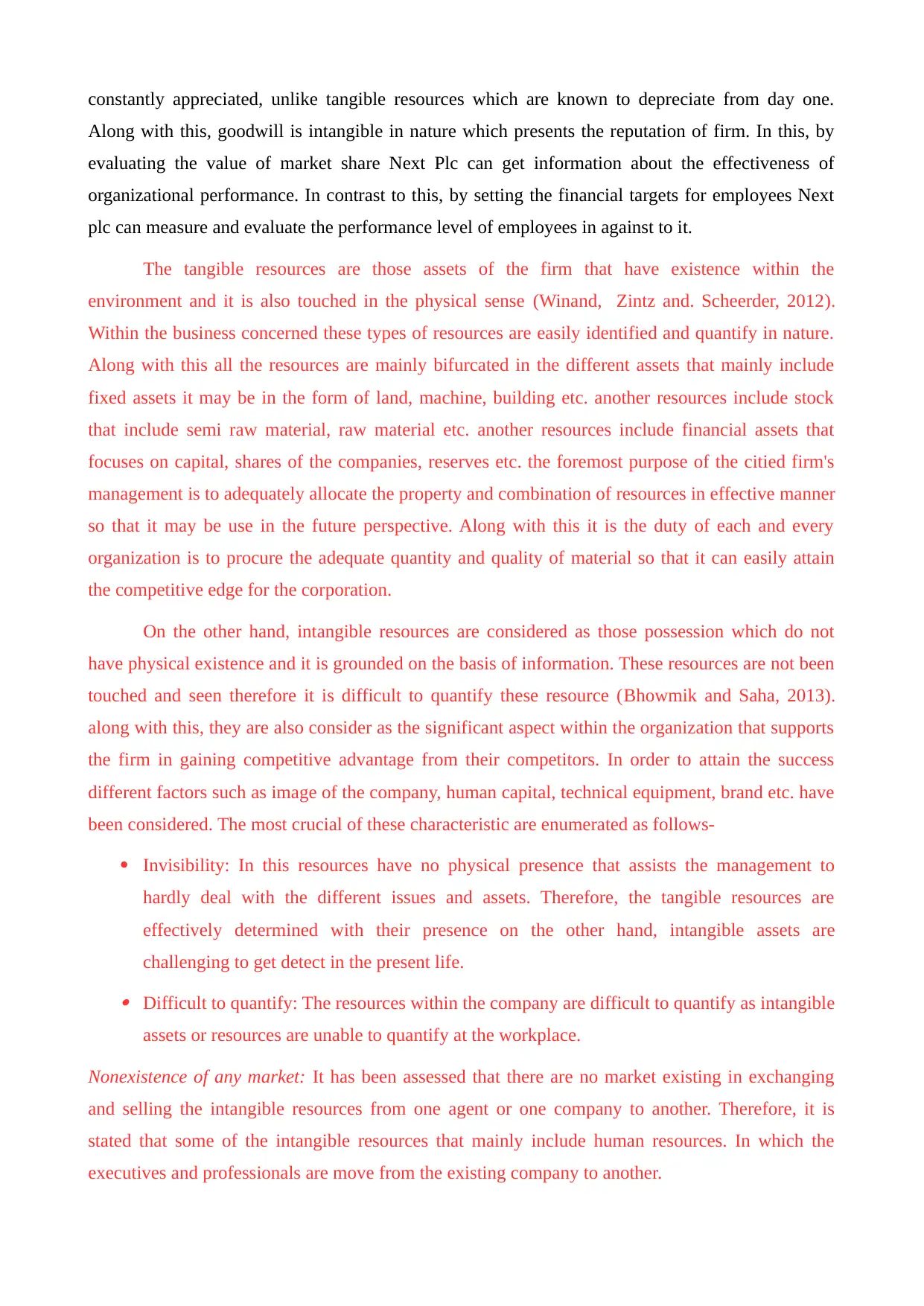
constantly appreciated, unlike tangible resources which are known to depreciate from day one.
Along with this, goodwill is intangible in nature which presents the reputation of firm. In this, by
evaluating the value of market share Next Plc can get information about the effectiveness of
organizational performance. In contrast to this, by setting the financial targets for employees Next
plc can measure and evaluate the performance level of employees in against to it.
The tangible resources are those assets of the firm that have existence within the
environment and it is also touched in the physical sense (Winand, Zintz and. Scheerder, 2012).
Within the business concerned these types of resources are easily identified and quantify in nature.
Along with this all the resources are mainly bifurcated in the different assets that mainly include
fixed assets it may be in the form of land, machine, building etc. another resources include stock
that include semi raw material, raw material etc. another resources include financial assets that
focuses on capital, shares of the companies, reserves etc. the foremost purpose of the citied firm's
management is to adequately allocate the property and combination of resources in effective manner
so that it may be use in the future perspective. Along with this it is the duty of each and every
organization is to procure the adequate quantity and quality of material so that it can easily attain
the competitive edge for the corporation.
On the other hand, intangible resources are considered as those possession which do not
have physical existence and it is grounded on the basis of information. These resources are not been
touched and seen therefore it is difficult to quantify these resource (Bhowmik and Saha, 2013).
along with this, they are also consider as the significant aspect within the organization that supports
the firm in gaining competitive advantage from their competitors. In order to attain the success
different factors such as image of the company, human capital, technical equipment, brand etc. have
been considered. The most crucial of these characteristic are enumerated as follows-
Invisibility: In this resources have no physical presence that assists the management to
hardly deal with the different issues and assets. Therefore, the tangible resources are
effectively determined with their presence on the other hand, intangible assets are
challenging to get detect in the present life. Difficult to quantify: The resources within the company are difficult to quantify as intangible
assets or resources are unable to quantify at the workplace.
Nonexistence of any market: It has been assessed that there are no market existing in exchanging
and selling the intangible resources from one agent or one company to another. Therefore, it is
stated that some of the intangible resources that mainly include human resources. In which the
executives and professionals are move from the existing company to another.
Along with this, goodwill is intangible in nature which presents the reputation of firm. In this, by
evaluating the value of market share Next Plc can get information about the effectiveness of
organizational performance. In contrast to this, by setting the financial targets for employees Next
plc can measure and evaluate the performance level of employees in against to it.
The tangible resources are those assets of the firm that have existence within the
environment and it is also touched in the physical sense (Winand, Zintz and. Scheerder, 2012).
Within the business concerned these types of resources are easily identified and quantify in nature.
Along with this all the resources are mainly bifurcated in the different assets that mainly include
fixed assets it may be in the form of land, machine, building etc. another resources include stock
that include semi raw material, raw material etc. another resources include financial assets that
focuses on capital, shares of the companies, reserves etc. the foremost purpose of the citied firm's
management is to adequately allocate the property and combination of resources in effective manner
so that it may be use in the future perspective. Along with this it is the duty of each and every
organization is to procure the adequate quantity and quality of material so that it can easily attain
the competitive edge for the corporation.
On the other hand, intangible resources are considered as those possession which do not
have physical existence and it is grounded on the basis of information. These resources are not been
touched and seen therefore it is difficult to quantify these resource (Bhowmik and Saha, 2013).
along with this, they are also consider as the significant aspect within the organization that supports
the firm in gaining competitive advantage from their competitors. In order to attain the success
different factors such as image of the company, human capital, technical equipment, brand etc. have
been considered. The most crucial of these characteristic are enumerated as follows-
Invisibility: In this resources have no physical presence that assists the management to
hardly deal with the different issues and assets. Therefore, the tangible resources are
effectively determined with their presence on the other hand, intangible assets are
challenging to get detect in the present life. Difficult to quantify: The resources within the company are difficult to quantify as intangible
assets or resources are unable to quantify at the workplace.
Nonexistence of any market: It has been assessed that there are no market existing in exchanging
and selling the intangible resources from one agent or one company to another. Therefore, it is
stated that some of the intangible resources that mainly include human resources. In which the
executives and professionals are move from the existing company to another.
Paraphrase This Document
Need a fresh take? Get an instant paraphrase of this document with our AI Paraphraser
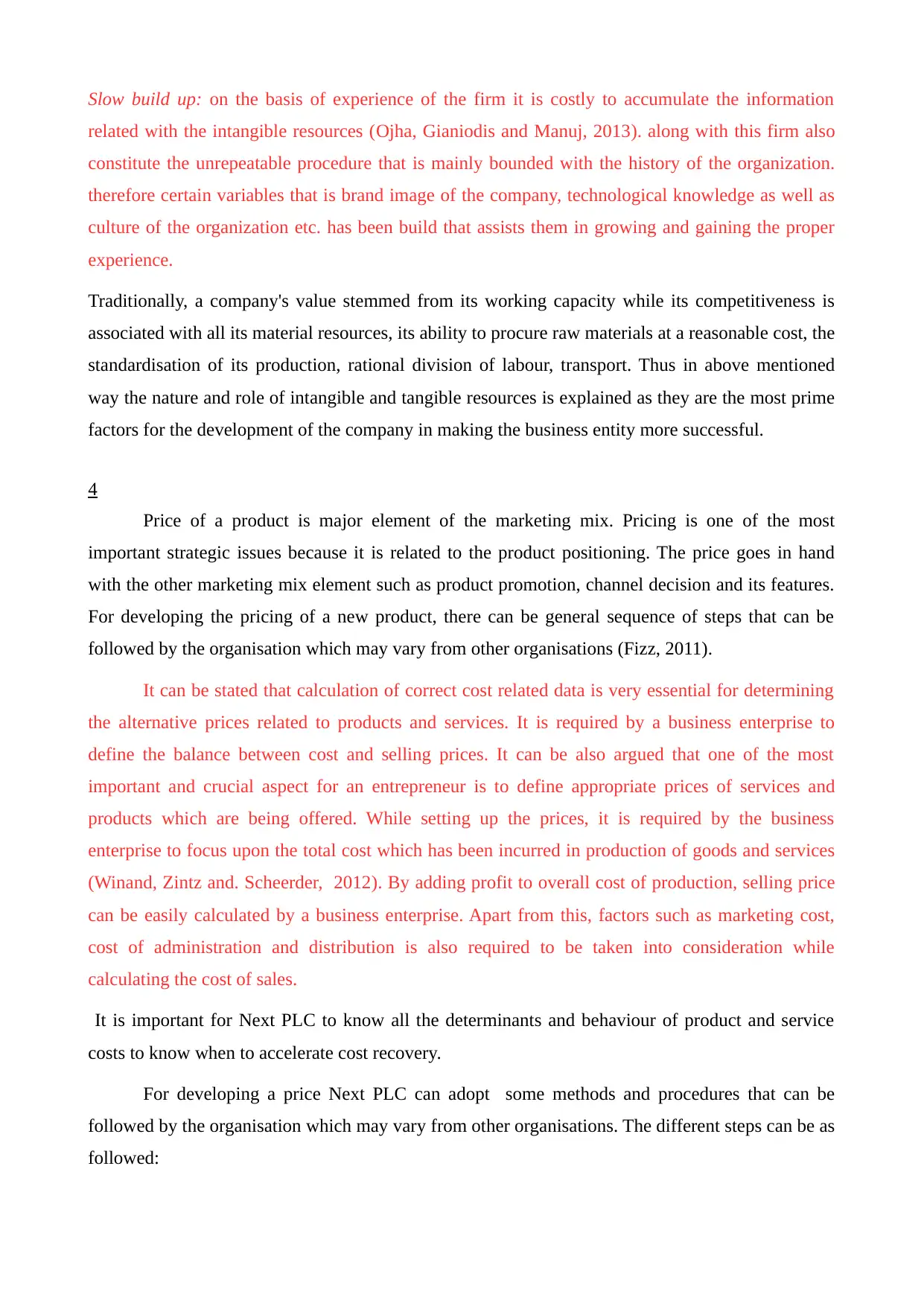
Slow build up: on the basis of experience of the firm it is costly to accumulate the information
related with the intangible resources (Ojha, Gianiodis and Manuj, 2013). along with this firm also
constitute the unrepeatable procedure that is mainly bounded with the history of the organization.
therefore certain variables that is brand image of the company, technological knowledge as well as
culture of the organization etc. has been build that assists them in growing and gaining the proper
experience.
Traditionally, a company's value stemmed from its working capacity while its competitiveness is
associated with all its material resources, its ability to procure raw materials at a reasonable cost, the
standardisation of its production, rational division of labour, transport. Thus in above mentioned
way the nature and role of intangible and tangible resources is explained as they are the most prime
factors for the development of the company in making the business entity more successful.
4
Price of a product is major element of the marketing mix. Pricing is one of the most
important strategic issues because it is related to the product positioning. The price goes in hand
with the other marketing mix element such as product promotion, channel decision and its features.
For developing the pricing of a new product, there can be general sequence of steps that can be
followed by the organisation which may vary from other organisations (Fizz, 2011).
It can be stated that calculation of correct cost related data is very essential for determining
the alternative prices related to products and services. It is required by a business enterprise to
define the balance between cost and selling prices. It can be also argued that one of the most
important and crucial aspect for an entrepreneur is to define appropriate prices of services and
products which are being offered. While setting up the prices, it is required by the business
enterprise to focus upon the total cost which has been incurred in production of goods and services
(Winand, Zintz and. Scheerder, 2012). By adding profit to overall cost of production, selling price
can be easily calculated by a business enterprise. Apart from this, factors such as marketing cost,
cost of administration and distribution is also required to be taken into consideration while
calculating the cost of sales.
It is important for Next PLC to know all the determinants and behaviour of product and service
costs to know when to accelerate cost recovery.
For developing a price Next PLC can adopt some methods and procedures that can be
followed by the organisation which may vary from other organisations. The different steps can be as
followed:
related with the intangible resources (Ojha, Gianiodis and Manuj, 2013). along with this firm also
constitute the unrepeatable procedure that is mainly bounded with the history of the organization.
therefore certain variables that is brand image of the company, technological knowledge as well as
culture of the organization etc. has been build that assists them in growing and gaining the proper
experience.
Traditionally, a company's value stemmed from its working capacity while its competitiveness is
associated with all its material resources, its ability to procure raw materials at a reasonable cost, the
standardisation of its production, rational division of labour, transport. Thus in above mentioned
way the nature and role of intangible and tangible resources is explained as they are the most prime
factors for the development of the company in making the business entity more successful.
4
Price of a product is major element of the marketing mix. Pricing is one of the most
important strategic issues because it is related to the product positioning. The price goes in hand
with the other marketing mix element such as product promotion, channel decision and its features.
For developing the pricing of a new product, there can be general sequence of steps that can be
followed by the organisation which may vary from other organisations (Fizz, 2011).
It can be stated that calculation of correct cost related data is very essential for determining
the alternative prices related to products and services. It is required by a business enterprise to
define the balance between cost and selling prices. It can be also argued that one of the most
important and crucial aspect for an entrepreneur is to define appropriate prices of services and
products which are being offered. While setting up the prices, it is required by the business
enterprise to focus upon the total cost which has been incurred in production of goods and services
(Winand, Zintz and. Scheerder, 2012). By adding profit to overall cost of production, selling price
can be easily calculated by a business enterprise. Apart from this, factors such as marketing cost,
cost of administration and distribution is also required to be taken into consideration while
calculating the cost of sales.
It is important for Next PLC to know all the determinants and behaviour of product and service
costs to know when to accelerate cost recovery.
For developing a price Next PLC can adopt some methods and procedures that can be
followed by the organisation which may vary from other organisations. The different steps can be as
followed:
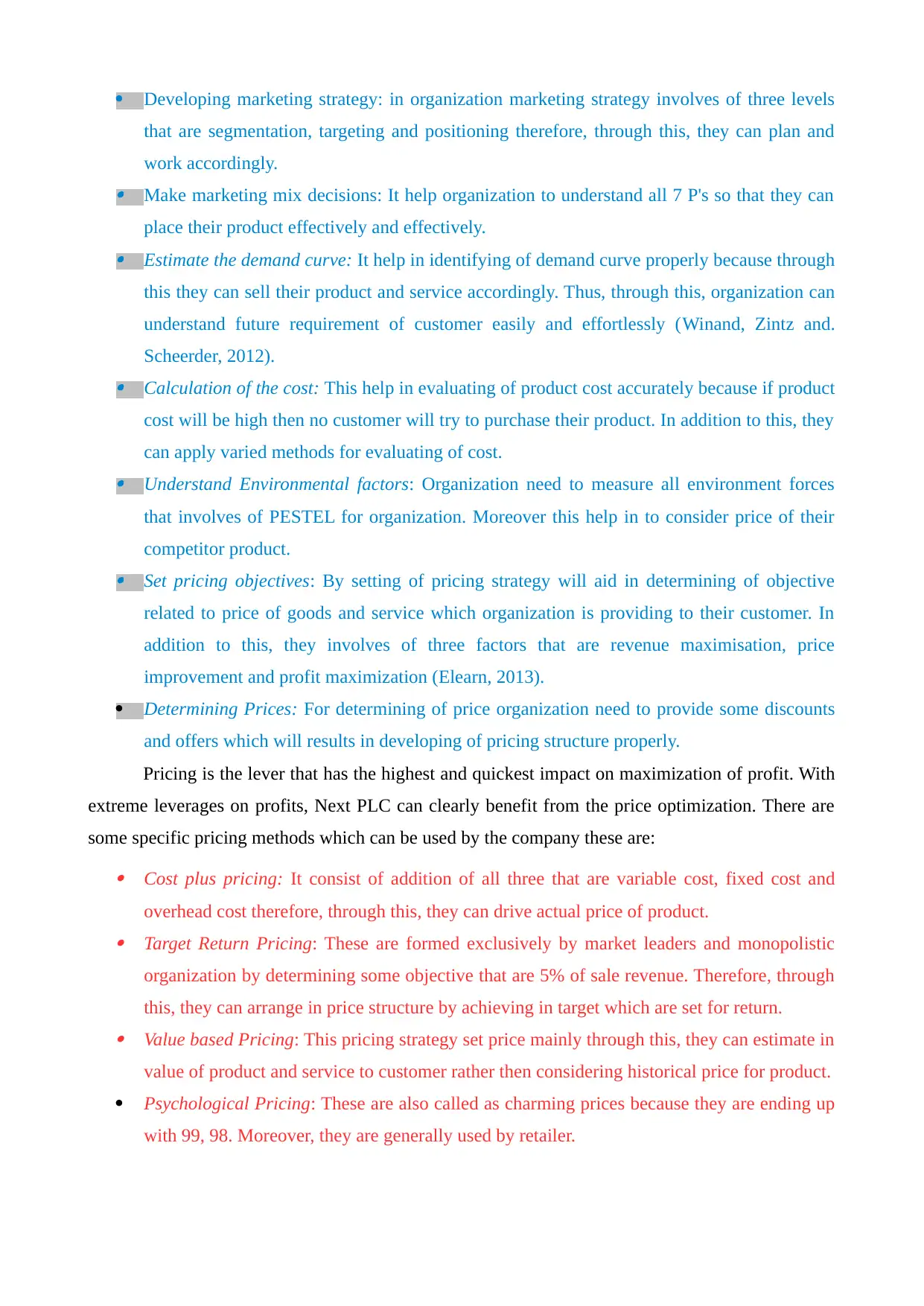
Developing marketing strategy: in organization marketing strategy involves of three levels
that are segmentation, targeting and positioning therefore, through this, they can plan and
work accordingly. Make marketing mix decisions: It help organization to understand all 7 P's so that they can
place their product effectively and effectively. Estimate the demand curve: It help in identifying of demand curve properly because through
this they can sell their product and service accordingly. Thus, through this, organization can
understand future requirement of customer easily and effortlessly (Winand, Zintz and.
Scheerder, 2012). Calculation of the cost: This help in evaluating of product cost accurately because if product
cost will be high then no customer will try to purchase their product. In addition to this, they
can apply varied methods for evaluating of cost. Understand Environmental factors: Organization need to measure all environment forces
that involves of PESTEL for organization. Moreover this help in to consider price of their
competitor product. Set pricing objectives: By setting of pricing strategy will aid in determining of objective
related to price of goods and service which organization is providing to their customer. In
addition to this, they involves of three factors that are revenue maximisation, price
improvement and profit maximization (Elearn, 2013).
Determining Prices: For determining of price organization need to provide some discounts
and offers which will results in developing of pricing structure properly.
Pricing is the lever that has the highest and quickest impact on maximization of profit. With
extreme leverages on profits, Next PLC can clearly benefit from the price optimization. There are
some specific pricing methods which can be used by the company these are:
Cost plus pricing: It consist of addition of all three that are variable cost, fixed cost and
overhead cost therefore, through this, they can drive actual price of product. Target Return Pricing: These are formed exclusively by market leaders and monopolistic
organization by determining some objective that are 5% of sale revenue. Therefore, through
this, they can arrange in price structure by achieving in target which are set for return. Value based Pricing: This pricing strategy set price mainly through this, they can estimate in
value of product and service to customer rather then considering historical price for product.
Psychological Pricing: These are also called as charming prices because they are ending up
with 99, 98. Moreover, they are generally used by retailer.
that are segmentation, targeting and positioning therefore, through this, they can plan and
work accordingly. Make marketing mix decisions: It help organization to understand all 7 P's so that they can
place their product effectively and effectively. Estimate the demand curve: It help in identifying of demand curve properly because through
this they can sell their product and service accordingly. Thus, through this, organization can
understand future requirement of customer easily and effortlessly (Winand, Zintz and.
Scheerder, 2012). Calculation of the cost: This help in evaluating of product cost accurately because if product
cost will be high then no customer will try to purchase their product. In addition to this, they
can apply varied methods for evaluating of cost. Understand Environmental factors: Organization need to measure all environment forces
that involves of PESTEL for organization. Moreover this help in to consider price of their
competitor product. Set pricing objectives: By setting of pricing strategy will aid in determining of objective
related to price of goods and service which organization is providing to their customer. In
addition to this, they involves of three factors that are revenue maximisation, price
improvement and profit maximization (Elearn, 2013).
Determining Prices: For determining of price organization need to provide some discounts
and offers which will results in developing of pricing structure properly.
Pricing is the lever that has the highest and quickest impact on maximization of profit. With
extreme leverages on profits, Next PLC can clearly benefit from the price optimization. There are
some specific pricing methods which can be used by the company these are:
Cost plus pricing: It consist of addition of all three that are variable cost, fixed cost and
overhead cost therefore, through this, they can drive actual price of product. Target Return Pricing: These are formed exclusively by market leaders and monopolistic
organization by determining some objective that are 5% of sale revenue. Therefore, through
this, they can arrange in price structure by achieving in target which are set for return. Value based Pricing: This pricing strategy set price mainly through this, they can estimate in
value of product and service to customer rather then considering historical price for product.
Psychological Pricing: These are also called as charming prices because they are ending up
with 99, 98. Moreover, they are generally used by retailer.
⊘ This is a preview!⊘
Do you want full access?
Subscribe today to unlock all pages.

Trusted by 1+ million students worldwide
1 out of 15
Related Documents
Your All-in-One AI-Powered Toolkit for Academic Success.
+13062052269
info@desklib.com
Available 24*7 on WhatsApp / Email
![[object Object]](/_next/static/media/star-bottom.7253800d.svg)
Unlock your academic potential
Copyright © 2020–2025 A2Z Services. All Rights Reserved. Developed and managed by ZUCOL.





